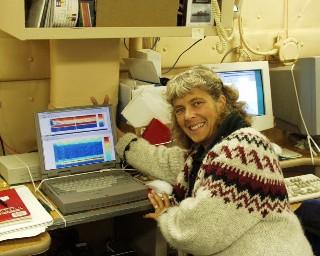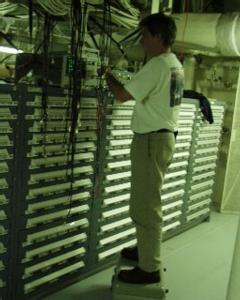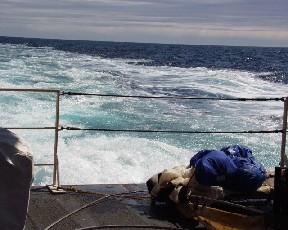4 June, 2000
Current Events
June 4, Sunday
Dirty data. That's one thing that scientist Jules Hummon can't stand. Dr.
Hummon is an expert from the University of Hawaii on acoustics (sound). She
is on board the Healy to test an instrument called the ADCP (Acoustic
Doppler Current Profiler). She wants to make sure that the data she collects
from the ADCP is the data she is looking for.
The ADCP gives scientists information about ocean currents. Currents are
like rivers of moving water. The ADCP shows the direction and speed a
current is traveling.
The way it works is similar to the way bottom mapping sonar systems like
SEABEAM work. The transducers "shout" down into the water, and then wait to
see how long it takes to "hear" the echo. Instead of shouting "Hello down
there!", they make a pinging noise.
The problem is that the ship is also making a lot of different noises at the
same time. Some of those noises sound a lot like the "ping" from the ADCP.
These noises get in the way of the transducers hearing those pings.
It's just like trying to listen to the television while your younger brother
is screaming in the next room. You miss some of what is being said on T.V.
This is called "acoustic interference" because the sounds ("acoustics") that
your brother is making interfere with what you are trying to hear.
There are other things that cause acoustic interference with the ADCP. When
the ship moves quickly through the water, it leaves a trail of bubbles. If
there are too many bubbles close to the ship, the transducer can't hear the
pings from the ADCP. It would be like trying to hear someone talking while a
swarm of bumblebees buzzed around your face. The buzzing would block out all
other sounds.
All this interference and noise creates "dirty data". "Dirty data" isn't
really dirty, but it doesn't tell scientists what they want to know. That's
why Dr. Hummon doesn't like it. And that's why scientists aboard the Healy
are spending so much time making sure that the ADCP and all of the other
instruments on the ship work exactly the way they should. Then they can
spend their time looking at good, clean data.
Riddle of the day:
How is the ocean like a loaf of bread?
To find out, click on Susan's page:
Susanís Entry
Today.
DAILY DATA LOG (6/04/00):
Air Temperature: 36 degrees F
Clear skies, sunny
Latitude 52N
Longitude 52W

Jules Hummon is a scientist at the University of Hawaii.

The white marks on the left side of this graph show noise interference caused by bubbles from the ship.

Kevin is checking a monitor that shows the noise interference caused by pumps on the ship.

The trail of bubbles from the ship can cause acoustic interference.
Contact the TEA in the field at
.
If you cannot connect through your browser, copy the
TEA's e-mail address in the "To:" line of
your favorite e-mail package.
|
